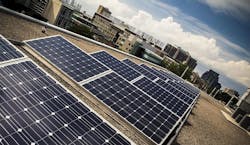Microgrid-friendly Toronto U. Named Top University in Sustainability by QS
The University of Toronto, which commissioned a microgrid as part of its direct-current technology research three years ago, was ranked as the No. 1 university globally in sustainability this month by QS Quacquarelli Symonds.
The higher education analysis firm's QS World University Rankings on Sustainability scored University of Toronto number one worldwide based on social and environmental factors. The school was followed in the QS World University Rankings by the University of California-Berkeley, University of Manchester in the United Kingdom, University of British Columbia in Canada and University of Auckland in New Zealand.
The study evaluated the universities in their approaches to environmental research and education and on-site energy efforts, in addition to other factors.
“At the University of Toronto, we believe that all sectors need to be playing a role in the transition to a more sustainable and just world,” Kristy Faccer, who is part of the school’s President’s Advisory Committee on Environment, Climate Change and Sustainability, said in a section of the QS Sustainability Ranking report.
“In research, we are exploring how to think and approach research with sustainability” as top of mind,” she was quoted in the QS report. “We are also collaborating with others to accelerate climate action implementation.”
In 2020, the University of Toronto commissioned an on-campus rooftop solar and energy storage microgrid. Located in the Energy Systems lab, the installation aids the researchers in studying DC microgrid and system integration technology. The microgrid also supplies power to DC loads such as LED lighting and more.
University Microgrids are the Big Plan on Campus
Panel Session at Microgrid 2024 in Baltimore
April 22-24: Register to Join the Revolution in Energy
WorleyParsons was contracted to install the DC microgrid system at the university.
Elsewhere in the QS rankings, the Massachusetts Institute of Technology was lauded for its research and on-campus work around sustainability in energy. The MIT Energy Initiative also has focused some of its work around hybrid and laboratory-scale microgrids.
About the Author
Rod Walton, Microgrid Knowledge Managing Editor
Managing Editor
For Microgrid Knowledge editorial inquiries, please contact Managing Editor Rod Walton at [email protected].
I’ve spent the last 15 years covering the energy industry as a newspaper and trade journalist. I was an energy writer and business editor at the Tulsa World before moving to business-to-business media at PennWell Publishing, which later became Clarion Events, where I covered the electric power industry. I joined Endeavor Business Media in November 2021 to help launch EnergyTech, one of the company’s newest media brands. I joined Microgrid Knowledge in July 2023.
I earned my Bachelors degree in journalism from the University of Oklahoma. My career stops include the Moore American, Bartlesville Examiner-Enterprise, Wagoner Tribune and Tulsa World, all in Oklahoma . I have been married to Laura for the past 33-plus years and we have four children and one adorable granddaughter. We want the energy transition to make their lives better in the future.
Microgrid Knowledge and EnergyTech are focused on the mission critical and large-scale energy users and their sustainability and resiliency goals. These include the commercial and industrial sectors, as well as the military, universities, data centers and microgrids. The C&I sectors together account for close to 30 percent of greenhouse gas emissions in the U.S.
Many large-scale energy users such as Fortune 500 companies, and mission-critical users such as military bases, universities, healthcare facilities, public safety and data centers, shifting their energy priorities to reach net-zero carbon goals within the coming decades. These include plans for renewable energy power purchase agreements, but also on-site resiliency projects such as microgrids, combined heat and power, rooftop solar, energy storage, digitalization and building efficiency upgrades.

